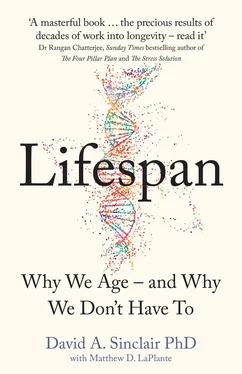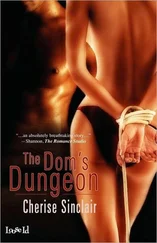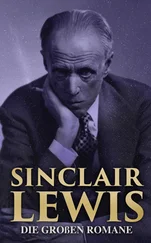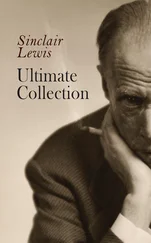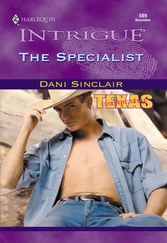David Sinclair, Matthew D. LaPlante
Lifespan
Thorsons
An imprint of HarperCollins Publishers
1 London Bridge Street
London SE1 9GF
www.harpercollins.co.uk
First published by Atria Books, an imprint of Simon & Schuster, Inc.
This UK edition published by Thorsons 2019
FIRST EDITION
© David Sinclair PhD 2019
Cover layout design © HarperCollins Publisher s Ltd 2019
Cover illustration © MGB Watercolor Art 2019
Illustrations and Sinclairfont by Catherine L. Delphia
Illustrations in Cast of Characters by David Sinclair
Thanks to Christine Liu and her team at the Innovative Genomics Institute (IGI) for permission to use the Glossary icons. Thanks to Wikipedia for biographical facts in the cast of characters.
A catalogue record of this book is available from the British Library
David Sinclair PhD asserts the moral right to be identified as the author of this work
All rights reserved under International and Pan-American Copyright Conventions. By payment of the required fees, you have been granted the nonexclusive, non-transferable right to access and read the text of this e-book on screen. No part of this text may be reproduced, transmitted, downloaded, decompiled, reverse engineered, or stored in or introduced into any information storage retrieval system, in any form or by any means, whether electronic or mechanical, now known or hereinafter invented, without the express written permission of HarperCollins e-books.
Find out about HarperCollins and the environment at www.harpercollins.co.uk/green
Source ISBN: 9780008353742
Ebook Edition © October 2019 ISBN: 9780008292362
Version 2019-10-29
Information about External Hyperlinks in this ebook
Please note that footnotes and endnotes in this ebook may contain hyperlinks to external websites as part of bibliographic citations. These hyperlinks have not been activated by the publisher, who cannot verify the accuracy of these links beyond the date of publication.
To my grandmother Vera, who taught me to see the world the way it could be
To my mother, Diana, who cared more about her children than herself
To my wife, Sandra, my bedrock
And to my great-great-grandchildren; I am looking forward to meeting you
THE BUSH.In the wild and wonderful world of the Garigal clan, waterfalls and saltwater estuaries wind through ancient sandstone escarpments, under shadowy canopies of charred bloodwoods, angophoras, and scribbly gums that kookaburras, currawongs, and wallabies call home.
INTRODUCTION
A GRANDMOTHER’S PRAYER
I GREW UP ON THE EDGE OF THE BUSH. IN FIGURATIVE TERMS, MY BACKYARDwas a hundred-acre wood. In literal terms, it was much bigger than that. It went on as far as my young eyes could see, and I never grew tired of exploring it. I would hike and hike, stopping to study the birds, the insects, the reptiles. I pulled things apart. I rubbed the dirt between my fingers. I listened to the sounds of the wild and tried to connect them to their sources.
And I played. I made swords from sticks and forts from rocks. I climbed trees and swung on branches and dangled my legs over steep precipices and jumped off of things that I probably shouldn’t have jumped off. I imagined myself as an astronaut on a distant planet. I pretended to be a hunter on safari. I lifted my voice for the animals as though they were an audience at the opera house.
“Coooeey!” I would holler, which means “Come here” in the language of the Garigal people, the original inhabitants.
I wasn’t unique in any of this, of course. There were lots of kids in the northern suburbs of Sydney who shared my love of adventure and exploration and imagination. We expect this of children. We want them to play this way.
Until, of course, they’re “too old” for that sort of thing. Then we want them to go to school. Then we want them to go to work. To find a partner. To save up. To buy a house.
Because, you know, the clock is ticking.
My grandmother was the first person to tell me that it didn’t have to be that way. Or, I guess, she didn’t tell me so much as show me.
She had grown up in Hungary, where she spent Bohemian summers swimming in the cool waters of Lake Balaton and hiking in the mountains of its northern shore at a holiday resort that catered to actors, painters, and poets. In the winter months, she helped run a hotel in the Buda Hills before the Nazis took it over and converted it to the central command of the Schutzstaffel, or “SS.”
A decade after the war, in the early days of the Soviet occupation, the Communists began to shut down the borders. When her mother tried to cross illegally into Austria, she was caught, arrested, and sentenced to two years in jail and died shortly after. During the Hungarian Uprising in 1956, my grandmother wrote and distributed anti-Communist newsletters in the streets of Budapest. After the revolution was crushed, the Soviets began arresting tens of thousands of dissidents, and she fled to Australia with her son, my father, reasoning that it was the furthest they could get from Europe.
She never set foot in Europe again, but she brought every bit of Bohemia with her. She was, I have been told, one of the first women to sport a bikini in Australia and got chased off Bondi Beach because of it. She spent years living in New Guinea—which even today is one of the most intensely rugged places on our planet—all by herself.
Though her bloodline was Ashkenazi Jew and she had been raised a Lutheran, my grandmother was a very secular person. Our equivalent of the Lord’s Prayer was the English author Alan Alexander Milne’s poem “Now We Are Six,” which ends:
But now I am six,
I’m as clever as clever.
So I think I’ll be six now
for ever and ever.
She read that poem to my brother and me again and again. Six, she told us, was the very best age, and she did her damnedest to live life with the spirit and awe of a child of that age.
Even when we were very young, my grandmother didn’t want us to call her “grandmother.” Nor did she like the Hungarian term, “nagymama,” or any of the other warm terms of endearment such as “bubbie,” “grandma,” and “nana.”
To us boys, and everyone else, she was simply Vera.
Vera taught me to drive, swerving and swaying across all of the lanes, “dancing” to whatever music was on the car’s radio. She told me to enjoy my youth, to savor the feeling of being young. Adults, she said, always ruined things. Don’t grow up, she said. Never grow up.
Well into her 60s and 70s, she was still what we call “young at heart,” drinking wine with friends and family, eating good food, telling great stories, helping the poor, sick, and less fortunate, pretending to conduct symphonies, laughing late into the night. By just about anyone’s standard, that’s the mark of a “life well lived.”
But yes, the clock was ticking.
By her mid-80s, Vera was a shell of her former self, and the final decade of her life was hard to watch. She was frail and sick. She still had enough wisdom left to insist that I marry my fiancée, Sandra, but by then music gave her no joy and she hardly got out of her chair; the vibrancy that had defined her was gone.
Toward the end, she gave up hope. “This is just the way it goes,” she told me.
She died at the age of 92. And, in the way we’ve been taught to think about these things, she’d had a good, long life. But the more I have thought about it, the more I have come to believe that the person she truly was had been dead many years at that point.
Читать дальше
